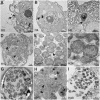Developmental Cycle and Genome Analysis of "Rubidus massiliensis," a New Vermamoeba vermiformis Pathogen
- PMID: 27014641
- PMCID: PMC4791399
- DOI: 10.3389/fcimb.2016.00031
Developmental Cycle and Genome Analysis of "Rubidus massiliensis," a New Vermamoeba vermiformis Pathogen
Abstract
The study of amoeba-associated Chlamydiae is a dynamic field in which new species are increasingly reported. In the present work, we characterized the developmental cycle and analyzed the genome of a new member of this group associated with Vermamoeba vermiformis, we propose to name "Rubidus massiliensis." This bacterium is well-adapted to its amoeba host and do not reside inside of inclusion vacuoles after phagocytosis. It has a developmental cycle typical of this family of bacteria, with a transition from condensed elementary bodies to hypodense replicative reticulate bodies. Multiplication occurs through binary fission of the reticulate bodies. The genome of "R. massiliensis" consists of a 2.8 Mbp chromosome and two plasmids (pRm1, pRm2) consisting of 39,075 bp and 80,897 bp, respectively, a feature that is unique within this group. The Re-analysis of the Chlamydiales genomes including the one of "R. massiliensis" slightly modified the previous phylogeny of the tlc gene encoding the ADP/ATP translocase. Our analysis suggested that the tlc gene could have been transferred to plant and algal plastids before the transfer to Rickettsiales, and that this gene was probably duplicated several times.
Keywords: Rubidus massiliensis; Vermamoeba vermiformis; chlamydiae; co-culture; host specificity.
Figures





Similar articles
-
Developmental Cycle and Genome Analysis of Protochlamydia massiliensis sp. nov. a New Species in the Parachlamydiacae Family.Front Cell Infect Microbiol. 2017 Aug 31;7:385. doi: 10.3389/fcimb.2017.00385. eCollection 2017. Front Cell Infect Microbiol. 2017. PMID: 28913180 Free PMC article.
-
Protochlamydia phocaeensis sp. nov., a new Chlamydiales species with host dependent replication cycle.Microbes Infect. 2017 Jun;19(6):343-350. doi: 10.1016/j.micinf.2017.02.003. Epub 2017 Mar 7. Microbes Infect. 2017. PMID: 28279734
-
Babela massiliensis, a representative of a widespread bacterial phylum with unusual adaptations to parasitism in amoebae.Biol Direct. 2015 Mar 31;10:13. doi: 10.1186/s13062-015-0043-z. Biol Direct. 2015. PMID: 25884386 Free PMC article.
-
The increasing importance of Vermamoeba vermiformis.J Eukaryot Microbiol. 2021 Sep;68(5):e12857. doi: 10.1111/jeu.12857. Epub 2021 Jun 30. J Eukaryot Microbiol. 2021. PMID: 33987951 Review.
-
[Environmental Chlamydiae with medical significance].Dtsch Med Wochenschr. 2011 Oct;136(41):2100-5. doi: 10.1055/s-0031-1292020. Epub 2011 Oct 4. Dtsch Med Wochenschr. 2011. PMID: 21971886 Review. German.
Cited by
-
Vermamoeba vermiformis: a Free-Living Amoeba of Interest.Microb Ecol. 2018 Nov;76(4):991-1001. doi: 10.1007/s00248-018-1199-8. Epub 2018 May 8. Microb Ecol. 2018. PMID: 29737382 Review.
-
Cedratvirus, a Double-Cork Structured Giant Virus, is a Distant Relative of Pithoviruses.Viruses. 2016 Nov 3;8(11):300. doi: 10.3390/v8110300. Viruses. 2016. PMID: 27827884 Free PMC article.
-
Developmental Cycle and Genome Analysis of Protochlamydia massiliensis sp. nov. a New Species in the Parachlamydiacae Family.Front Cell Infect Microbiol. 2017 Aug 31;7:385. doi: 10.3389/fcimb.2017.00385. eCollection 2017. Front Cell Infect Microbiol. 2017. PMID: 28913180 Free PMC article.
-
Diversity of Giant Viruses Infecting Vermamoeba vermiformis.Front Microbiol. 2022 Apr 22;13:808499. doi: 10.3389/fmicb.2022.808499. eCollection 2022. Front Microbiol. 2022. PMID: 35602053 Free PMC article. Review.
-
Phylogenetic Diversity of NTT Nucleotide Transport Proteins in Free-Living and Parasitic Bacteria and Eukaryotes.Genome Biol Evol. 2017 Feb 1;9(2):480-487. doi: 10.1093/gbe/evx015. Genome Biol Evol. 2017. PMID: 28164241 Free PMC article.
References
Publication types
MeSH terms
Substances
LinkOut - more resources
Full Text Sources
Other Literature Sources
Miscellaneous

